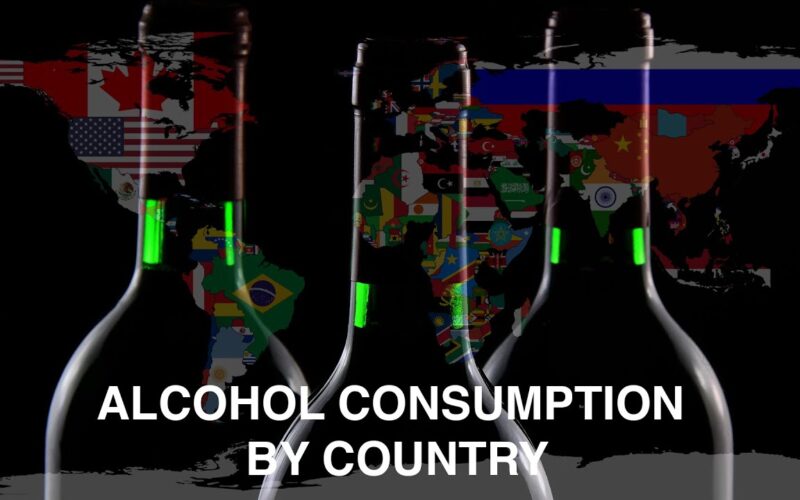Ever wondered which nations hold the title for the world’s heaviest drinkers? While you might assume it’s a tie between Ireland and Russia, the reality is far more surprising.
The countries that drink the most alcohol span across Europe, with some unexpected leaders that might challenge your assumptions about global drinking habits.
Understanding alcohol consumption patterns reveals fascinating insights into cultural traditions, economic factors, and social behaviors that shape how different societies approach drinking.
From beer-loving Czech Republic to wine-rich France, these nations demonstrate that heavy drinking isn’t just about quantity—it’s deeply intertwined with history, tradition, and social identity.
Czech Republic: The Undisputed Champion
The Czech Republic doesn’t just lead the world in alcohol consumption—it dominates it. Czechia has ranked as the world’s top consumer for 30 years in a row in one annual report, totaling 188.5 liters per person, per year, which is more than three times what Americans consume annually.
What makes Czech drinking culture so unique isn’t just the quantity, but the quality and social significance of beer. Beer has been brewed in the region for over a thousand years, and the Czech Republic continues this tradition with exceptional craftsmanship. The country’s pivní kultura (beer culture) represents more than just drinking—it’s a cornerstone of Czech identity and social interaction.
Did You Know? Czechs prefer to do their beer-drinking in pubs rather than at home. Drinking beer is an opportunity to meet with friends, making it a social activity rather than solitary consumption.
Beer gardens and traditional pubs serve as community gathering spaces where locals discuss everything from football to politics. The cultural importance of beer extends beyond mere consumption—it’s woven into the fabric of Czech social life, business meetings, and family celebrations.
For visitors interested in experiencing authentic Czech beer culture, Czech Tourism offers comprehensive guides to traditional breweries and beer halls throughout the country. The Czech Beer and Malt Association provides detailed information about the country’s brewing heritage and current industry statistics.
Latvia: Nordic Drinking Traditions
Latvia consistently ranks among the world’s heaviest drinking nations, with alcohol consumption deeply embedded in Baltic cultural traditions. The country’s drinking patterns reflect both historical influences from German and Russian cultures and modern Nordic social customs.
Latvian drinking culture centers around strong spirits, particularly vodka and locally produced herbal liqueurs. Unlike the pub culture of Czech Republic, Latvian drinking often occurs in private settings during family gatherings and traditional celebrations.
Key Statistics:
- Average consumption: 12.2 liters of pure alcohol per capita annually
- Primary beverages: Vodka (40%), beer (35%), wine (15%)
- Cultural significance: Integral to traditional festivals and family ceremonies
The country’s harsh winters contribute to higher alcohol consumption rates, as drinking serves both social and practical purposes during long, dark months. Traditional Latvian celebrations like Midsummer (Jāņi) involve communal drinking as part of cultural preservation efforts.
Moldova: Wine Country’s Hidden Champion
Moldova might surprise many as one of the world’s top alcohol-consuming nations. This small Eastern European country has transformed its ancient winemaking traditions into a modern drinking culture that rivals any wine-producing region globally.
Pro Tip: Moldova produces some of Europe’s finest wines at fraction of the cost found in Western countries, making quality alcohol more accessible to the general population.
The country’s alcohol consumption statistics reflect its position as a major wine producer, where drinking quality wine is considered both affordable and culturally appropriate. Moldovan families often produce their own wine, creating a culture where alcohol consumption begins early and continues throughout life as part of daily meals and social interactions.
Moldova’s unique position between Romanian and Russian cultural influences has created a drinking culture that combines:
- Traditional winemaking techniques passed down through generations
- Strong spirits consumption influenced by Russian traditions
- Social drinking customs that emphasize hospitality and community
Germany: Beer Gardens and Oktoberfest
Germany’s reputation for beer consumption is well-deserved, with the country maintaining consistently high alcohol consumption rates driven by centuries-old brewing traditions and social customs. German drinking culture extends far beyond the famous Oktoberfest celebration, encompassing daily social interactions and business customs.
The German approach to alcohol consumption emphasizes quality over quantity, with strict purity laws (Reinheitsgebot) governing beer production since 1516. This focus on quality has created a culture where drinking beer is considered both socially acceptable and culturally important.
German Drinking Culture Highlights:
- Beer Gardens: Outdoor social spaces where families gather for meals and conversation
- Feierabend: The tradition of enjoying beer after work as a social activity
- Regional Varieties: Each region produces distinct beer styles reflecting local preferences
- Integration with Food: Beer consumption typically accompanies meals rather than standalone drinking
German businesses often conduct informal meetings in beer gardens, and it’s common for colleagues to share drinks after work. This integration of alcohol into professional and social life contributes to higher consumption rates while maintaining cultural acceptance.
For those interested in exploring German beer culture, German Beer Institute provides extensive information about brewing traditions and cultural significance.
Lithuania: Baltic Drinking Traditions
Lithuania consistently ranks among the world’s heaviest drinking nations, with Lithuania (12.3 litres of pure alcohol per capita) leading global consumption in some recent studies. The country’s drinking culture reflects both historical Baltic traditions and modern social pressures.
Lithuanian drinking patterns show interesting seasonal variations, with consumption peaks during traditional celebrations and long winter months. The country’s cultural relationship with alcohol involves both celebration and social challenges, as high consumption rates correlate with various social issues.
Cultural Factors Contributing to High Consumption:
- Traditional celebrations requiring alcohol consumption
- Social acceptance of regular drinking
- Economic factors making alcohol relatively affordable
- Historical cultural practices around hospitality and social bonding
The Lithuanian government has implemented various public health initiatives to address consumption levels while respecting cultural traditions. These efforts include education programs, taxation policies, and support for alternative social activities. For current health statistics and policy information, Lithuania’s Health Ministry provides regular updates on alcohol-related public health initiatives.
Ireland: More Than Just Pubs
Ireland’s drinking culture extends far beyond the stereotypical pub scene, encompassing complex social, economic, and cultural factors that contribute to high alcohol consumption rates. Irish drinking traditions reflect centuries of social customs, economic influences, and cultural identity formation.
The Irish pub serves as more than just a place to drink—it’s a community center where locals gather for conversation, music, and social connection. Traditional Irish sessions (seisiún) combine music, storytelling, and social drinking in ways that strengthen community bonds.
Irish Drinking Culture Elements:
- Pub Culture: Central social gathering spaces in every community
- Traditional Music: Alcohol consumption often accompanies musical performances
- Hospitality Traditions: Offering drinks to guests is considered essential courtesy
- Seasonal Celebrations: St. Patrick’s Day and other festivals emphasize drinking as cultural expression
Despite stereotypes, Irish drinking culture includes strong traditions of moderation and social responsibility. Many Irish families maintain customs around responsible drinking, and the country has implemented progressive policies addressing alcohol-related social issues.
Modern Ireland balances respect for traditional drinking customs with awareness of health and social implications, creating a nuanced approach to alcohol consumption that other countries study as a model.
Spain: Wine, Social Life, and Moderation
Spain presents an interesting case study in alcohol consumption, where high overall consumption rates mask a culture that actually emphasizes moderation and social drinking. Spanish drinking customs center around wine consumption with meals and social gatherings that extend throughout the day.
The Spanish approach to alcohol consumption differs significantly from Northern European patterns, with emphasis on:
- Wine with Meals: Regular consumption of wine during lunch and dinner
- Social Drinking: Alcohol consumption as part of extended social gatherings
- Tapas Culture: Small plates accompanied by wine or beer throughout the evening
- Family Integration: Multi-generational drinking customs that include responsible consumption education
Regional Variations in Spanish Drinking Culture:
| Region | Primary Beverage | Cultural Context | Consumption Pattern |
|---|---|---|---|
| Andalusia | Wine, Beer | Tapas culture | Social, evening-focused |
| Catalonia | Wine, Cava | Business meals | Meal-integrated |
| Galicia | Wine, Spirits | Traditional celebrations | Seasonal, ceremonial |
| Madrid | Mixed beverages | Urban social life | Extended social hours |
Spanish drinking culture demonstrates how high consumption rates can coexist with relatively low rates of alcohol-related problems when consumption is integrated into social and cultural structures that emphasize moderation and community.
France: Wine Country Excellence
France’s position among the world’s heaviest drinking nations reflects the country’s deep cultural integration of wine into daily life, social customs, and national identity. France (11.7 litres) maintains consistently high consumption rates driven by centuries of winemaking tradition and social customs that treat wine consumption as both art and lifestyle.
French drinking culture emphasizes:
- Wine Education: Understanding wine varieties, production methods, and proper consumption
- Meal Integration: Wine consumption as essential complement to cuisine
- Social Rituals: Specific customs around wine selection, serving, and appreciation
- Regional Pride: Local wine production as source of community identity
The French approach to alcohol consumption serves as a model for many other countries, demonstrating how high consumption rates can coexist with cultural sophistication and social responsibility. French families often introduce children to wine appreciation at early ages, creating lifelong habits of responsible consumption.
Did You Know? The French paradox—high wine consumption with relatively low rates of heart disease—has sparked global interest in the health benefits of moderate wine consumption.
French wine regions like Bordeaux, Burgundy, and Champagne not only produce world-class wines but also maintain cultural traditions that make wine consumption an integral part of daily life. For wine enthusiasts, French Wine Society offers extensive resources about French wine culture and traditions. Additionally, Wines of France provides comprehensive information about French wine regions, production methods, and tasting experiences.
Bulgaria: Balkan Traditions
Bulgaria’s high alcohol consumption rates reflect the country’s position at the crossroads of European and Asian drinking cultures. Bulgarian drinking customs combine Slavic traditions with Mediterranean influences, creating unique patterns of alcohol consumption that emphasize both celebration and social bonding.
Traditional Bulgarian celebrations often center around rakia (fruit brandy) consumption, with specific customs governing how, when, and why alcohol is consumed. These traditions serve important social functions, strengthening family bonds and community relationships.
Bulgarian Drinking Customs:
- Rakia Culture: Traditional fruit brandies consumed during celebrations
- Hospitality Requirements: Offering alcohol to guests as sign of respect
- Seasonal Celebrations: Specific holidays requiring alcohol consumption
- Family Traditions: Multi-generational customs around alcohol production and consumption
The country’s wine production industry also contributes to high consumption rates, with many Bulgarian families maintaining traditions of home winemaking that date back centuries. These practices create cultural contexts where regular alcohol consumption is considered normal and socially acceptable.
Luxembourg: Small Country, Big Consumption
Luxembourg’s position among the world’s heaviest drinking nations reflects the country’s unique cultural position at the intersection of French, German, and Belgian influences. This small European nation has developed drinking customs that combine elements from all three neighboring cultures.
Factors Contributing to High Consumption:
- Cultural Diversity: Multiple drinking traditions within single country
- Economic Prosperity: High disposable income enabling quality alcohol consumption
- Social Integration: Alcohol consumption as part of business and social customs
- Geographic Influences: Proximity to major wine and beer producing regions
Luxembourg’s drinking culture demonstrates how small countries can maintain distinct alcohol consumption patterns while being influenced by larger neighboring cultures. The country’s high consumption rates reflect both prosperity and cultural traditions that emphasize quality alcohol consumption.
Pro Tip: Luxembourg produces excellent wines and spirits that are often unknown outside the country, making it a hidden gem for alcohol enthusiasts.
Slovakia: Central European Traditions
Slovakia’s drinking culture reflects the country’s complex history and geographic position in Central Europe. Slovakian alcohol consumption patterns combine elements of Czech beer culture, Hungarian wine traditions, and unique local customs around spirits production.
Traditional Slovak drinking customs center around:
- Beer Culture: Influenced by Czech brewing traditions
- Wine Production: Local varieties unique to Slovak regions
- Spirits Traditions: Traditional fruit brandies and herbal liqueurs
- Social Customs: Specific protocols for drinking in different social situations
The country’s separation from Czech Republic in 1993 allowed Slovakia to develop distinct drinking customs while maintaining connections to broader Central European alcohol culture. These traditions contribute to consistently high consumption rates across different demographic groups.
Portugal: Wine and Tradition
Portugal’s high alcohol consumption rates reflect the country’s position as one of Europe’s oldest wine-producing regions. Portuguese drinking culture combines ancient winemaking traditions with modern social customs that emphasize wine consumption as both cultural practice and social activity.
Portuguese Drinking Culture Highlights:
- Port Wine: World-famous fortified wine production
- Vinho Verde: Light, refreshing wines for daily consumption
- Regional Varieties: Distinct wine styles from different Portuguese regions
- Social Integration: Wine consumption as part of daily meals and social gatherings
Portuguese families often maintain traditions around wine production, consumption, and appreciation that span multiple generations. These customs create cultural contexts where regular alcohol consumption is considered normal and beneficial for social bonding.
The country’s cork industry also connects to wine culture, as Portugal produces majority of the world’s cork, further integrating wine production into national identity and economic activity. The Portuguese Wine Institute offers comprehensive information about Portuguese wine varieties, regions, and cultural significance.
Romania: Surprising Statistics
Romania’s position among the world’s heaviest drinking nations often surprises people unfamiliar with the country’s drinking culture. Romania with 16.96 liters leads some consumption rankings, reflecting complex social and cultural factors that contribute to high alcohol consumption rates.
Romanian drinking culture combines:
- Traditional Celebrations: Specific holidays requiring alcohol consumption
- Regional Varieties: Different drinking customs across Romanian regions
- Social Functions: Alcohol consumption as part of business and social customs
- Cultural Heritage: Traditional methods of alcohol production and consumption
The country’s history of political and economic changes has created unique drinking patterns that reflect both traditional customs and modern social pressures. Romanian families often maintain customs around home alcohol production, creating cultural contexts where regular consumption is considered normal.
Russia: Cultural Complexity
Russia’s relationship with alcohol consumption represents one of the most complex and culturally significant drinking cultures globally. While Russia doesn’t always rank among the absolute highest consumption countries in recent statistics, the country’s cultural relationship with alcohol—particularly vodka—remains internationally recognized.
Russian drinking culture involves:
- Vodka Traditions: Specific customs around vodka consumption and social bonding
- Celebration Customs: Alcohol consumption as essential part of Russian celebrations
- Social Protocols: Complex rules governing when, how, and why alcohol is consumed
- Cultural Identity: Alcohol consumption as part of Russian national identity
The Russian government has implemented various policies to address alcohol consumption rates while respecting cultural traditions. These efforts include education programs, taxation policies, and social initiatives designed to promote responsible drinking habits.
Historical Context: Russian drinking customs reflect centuries of cultural development, political influences, and social changes that have shaped modern consumption patterns.
United Kingdom: Pub Culture and Social Drinking
The United Kingdom’s drinking culture centers around the institution of the pub, which serves as a cornerstone of British social life. UK alcohol consumption patterns reflect both traditional customs and modern social changes that have shaped contemporary drinking habits.
British Drinking Culture Elements:
- Pub Traditions: Central social gathering spaces in every community
- After-Work Drinking: Common social custom among colleagues
- Weekend Culture: Specific patterns of alcohol consumption during leisure time
- Regional Variations: Different drinking customs across England, Scotland, Wales, and Northern Ireland
The UK’s approach to alcohol consumption includes both celebration of traditional drinking customs and awareness of health and social implications. British families often maintain customs around responsible drinking while participating in social activities that emphasize alcohol consumption.
Modern British drinking culture balances respect for traditional pub customs with contemporary understanding of alcohol’s health and social effects. This balance creates ongoing discussions about alcohol policy, social responsibility, and cultural preservation.
For those interested in British pub culture, Campaign for Real Ale (CAMRA) provides extensive information about traditional brewing methods and pub customs throughout the UK.
Understanding Global Alcohol Consumption Patterns
The countries that drink the most alcohol demonstrate fascinating patterns that extend far beyond simple consumption statistics. These nations show how alcohol consumption intersects with cultural identity, social customs, economic factors, and historical traditions in complex ways.
Key Factors Contributing to High Consumption:
- Cultural Integration: Alcohol consumption as part of daily social life
- Economic Accessibility: Affordable alcohol enabling regular consumption
- Social Customs: Traditional practices requiring alcohol consumption
- Geographic Influences: Climate, agriculture, and regional traditions
- Historical Factors: Centuries of cultural development around alcohol consumption
Understanding these patterns provides insights into how different societies approach alcohol consumption, regulation, and cultural preservation. The countries with the highest consumption rates often demonstrate sophisticated approaches to balancing cultural traditions with health and social considerations.
Global Trends to Watch:
- Increasing awareness of health implications
- Cultural preservation efforts
- Economic factors affecting consumption patterns
- Government policies addressing alcohol consumption
- Social movements promoting responsible drinking
For comprehensive global alcohol statistics and trends, the World Health Organization provides regularly updated information about alcohol consumption patterns worldwide.
Conclusion: More Than Just Numbers
The countries that drink the most alcohol tell stories that extend far beyond consumption statistics. From Czech Republic’s beer gardens to France’s wine culture, these nations demonstrate how alcohol consumption becomes woven into the fabric of social life, cultural identity, and community bonding.
Understanding global alcohol consumption patterns reveals the complex relationships between culture, tradition, economics, and social behavior. While these countries maintain high consumption rates, many also demonstrate sophisticated approaches to managing alcohol’s role in society through education, regulation, and cultural practices that emphasize responsibility alongside tradition.
Whether you’re interested in exploring different drinking cultures, understanding global social patterns, or simply curious about how different societies approach alcohol consumption, these countries offer fascinating insights into the diverse ways humans integrate alcohol into their cultural and social lives.
The next time you raise a glass, remember that you’re participating in traditions that span centuries and connect you to millions of people around the world who share similar customs, celebrations, and social bonds through the simple act of drinking together.








